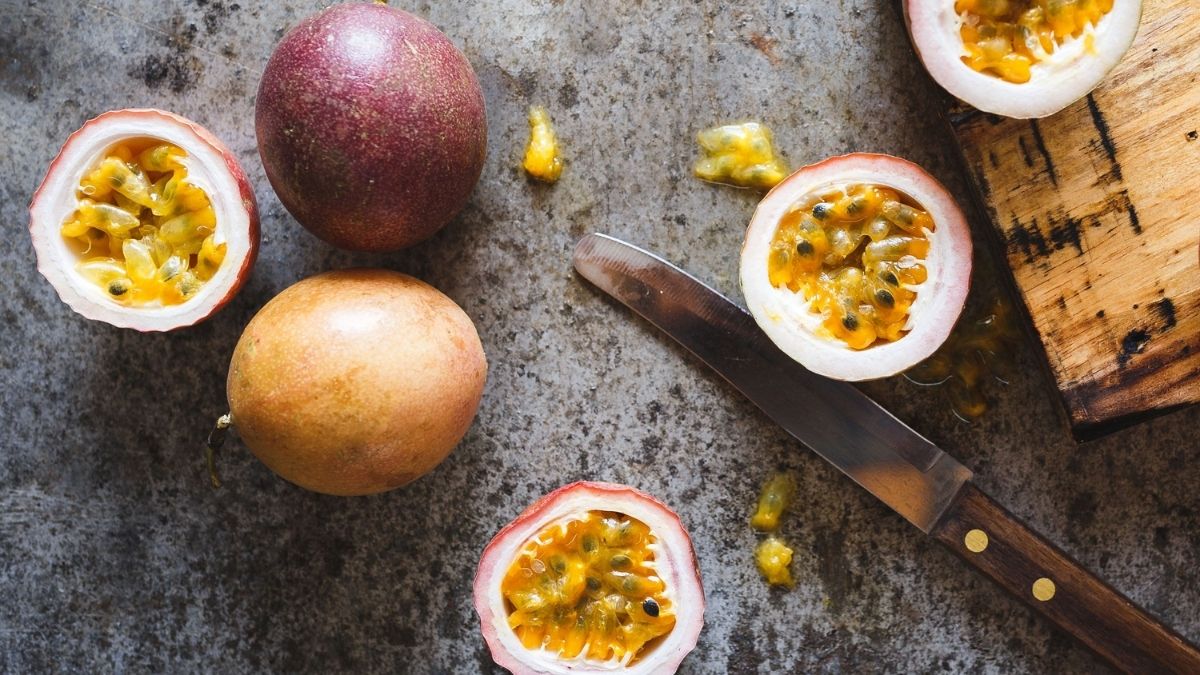Passion fruit is an unusual and unexpected item for many consumers due to its jelly-like viscosity, crunchy seeds, and fragrant aroma. The sweet, astringent flavor, on the other hand, is refreshing and complex and goes well with anything from lemon to coconut to chocolate. Passion fruits are little tropical fruits produced by a variety of passionflower. They have a tough, inedible skin that peels away to reveal a yellow, juicy seeded center that is edible when cut open. The most popular kind in the UK is passion fruit with a brown-purple outer skin, about the size of a golf ball.
Passion fruit, also known in India as Krishna phal, is a fruit that grows on the Passiflora vine and is endemic to Brazil, Paraguay, and Argentina. Even though it is a tropical fruit, some types can thrive in sub-tropical conditions, so it is grown in many places across Asia, Europe, and North America. Passion fruit is a tropical fruit that has yet to gain popularity in India. In most areas of the world, it is known as a sweet-tasting, aromatic, and nutritious fruit, and it is slowly but surely gaining ground in India, thanks to a growing awareness of health and fitness.
What is Passion Fruit?
Passion fruit is a South American subtropical fruit that grows on the Passiflora edulis vine, which is assumed to have originated in Paraguay, southern Brazil, and northern Argentina. It is widely consumed and cooked throughout South America. Passion fruit comes in various colors, including yellow, purple, and red, and individual fruits range in size from a plum to a grapefruit. The pulp is yellow. When passion fruit is selected young, the skin is taut and lustrous, but the skin becomes shriveled and wrinkled as the fruit ripens.
How to Use Passion Fruit?
First and foremost, knowing when a passion fruit is ripe is crucial. The color and texture of the skin are the most critical factors. The skin of immature passion fruit is smooth and green. Please wait a few days before eating these since they will ripen quickly. Depending on the type, it’s ready to eat when the skin becomes yellow, crimson, or dark purple, and the fruit softens, though the sweetness will develop further. When the skin of passion fruit is slightly wrinkled, it is ripe and has reached its maximum sweetness.
Even if you don’t eat the skin, thoroughly washing your passion fruit before using it is a bright idea. To begin, cut the fruit in half with a sharp knife. Because the skin is tough, you may wish to use a serrated knife to avoid squashing the fruit while cutting it. You’ll discover inside a gelatinous, yellow, seed-filled pulp that may be quickly scooped out with a spoon and eaten alone or added to drinks, sauces, and desserts.
To create juice, purée the pulp, seeds, and all, with a bit of water and sugar. After that, strain it to remove any remaining seed fragments and white pith (although both the seeds and the pith are edible). Smoothies with the juice of the fresh pulp are delicious. Recipes can also be made with pulp. To cook with the pulp, heat it slightly in the microwave or on the stove to make it more liquid and strainable. To remove the seeds, strain the warm pulp through a fine sieve. Some people save the seeds to use as a garnish.
What is the Taste of Passion Fruit?
When passion fruit is young, its flavor is astringent and refreshingly tangy, but it gets sweeter and more nuanced as it ripens. Citrus, melon, pineapple, and kiwi are some of its flavors. When the pulp becomes overripe, it develops a deep, nuanced, almost fermented flavor. The meat is jelly-like and can be eaten with a spoon after being scooped out. Although the seeds have a slight crunch, they are easy to consume and do not require removal.
It doesn’t have much flavor, is slightly bitter, and is spongy or cottony. Passion fruit is luscious, but that isn’t the idea. The flavor of passion fruit is sweet but tangy, with a pleasant perfume that enhances the eating experience. Because they are so unique, it’s difficult to compare them to any fruit, although if pressed, consider kiwi and pineapple.
What are the Health Benefits of Passion Fruit?
Vitamin C
Oranges, step aside. This antioxidant is abundant in passion fruit. It is used by your body to produce blood vessels, cartilage, muscles, and collagen, which keeps your skin looking young. It also aids in wound healing, inflammation reduction, and cell protection. Vitamin C helps prevent colds and certain malignancies when consumed in sufficient amounts.
Vitamin A
The pulp and crunchy seeds of the passion fruit contain 8% of the daily vitamin A requirement. It’s essential for the health of your eyes and cells and reproduction and immunity.
Fiber
It’s abundant in passion fruit, and fiber helps you feel satisfied for longer by keeping your bowels healthy and flowing. It also reduces cholesterol levels and your chances of diabetes, heart disease, and certain cancers.
Nutrients
Calcium, magnesium, phosphorus, potassium, and folate are all found in passion fruit, and these are highly beneficial to your kidneys, nerves, muscles, and heart rhythm.
Where can I Purchase Passion Fruit?
Passion fruit is commonly found in the vegetable area of larger grocery stores and supermarkets, and it’s available all year because it’s grown all over the world, from California to South America to Hawaii, Australia, and New Zealand. Ripe passion fruit will be purple, crimson, or yellow, with smooth skin in less ripe fruits and wrinkled skin in more ripe fruits. Green ones are unripe, but at room temperature, they will ripen in 3 to 5 days.
Many grocery stores and Latin markets sell frozen passion fruit pulp, which may be used in most recipes once thawed. Passion fruit pulp that has been frozen is usually reasonably acidic. Bottled passion fruit juice is sometimes available; however, it often contains additional sweeteners. If a recipe calls for decreased passion fruit juice, the bottled product may create a sweeter outcome than the recipe intended.
Is Passiflora a Passion Fruit?
Passion fruit, or Passiflora edulis, is a vine species of passion flower endemic to southern Brazil, Paraguay, and northern Argentina. Its sweet, seedy fruit is commercially grown in tropical and subtropical countries. Origin, botany, morphology, and structure are all factors to consider. The sour passion fruit (Passiflora edulis Sim.) is a Passifloraceae perennial vine (Rodriguez-Amaya, 2003). The Passifloraceae family has 18 genera, one of which is Passiflora, which contains 530 species, 50–60 of which are edible.
How do I Know When Passion Fruit is Ripe?
Passion fruit is mature when wrinkled and dark purple or yellowy-red, which isn’t what you’d expect from a ready-to-eat fruit but is valid here.
Green passion fruit is unripe and should be put on the counter to ripen for 3-7 days. The heavier fruits are the greatest since they contain more moisture. If you shake a passion fruit, you’ll notice a lot of liquid or pressure within, which suggests it’s full of excellent stuff! You can also use your nose to determine whether or not something is tropical. Avoid fruits with bruising or discoloration and any evidence of mold or rot, as you would with any other fruit.
How do I Cook with Passion Fruit?
Passion fruit can be used in various ways besides eating it raw and drinking the juice straight. Passion fruit can be used in both savory and sweet dishes, as well as in drinks. Passion fruit marinades and sauces complement fish, shrimp, and chicken, imparting a tropical island flavor to these foods.
Passion fruit frequently appears in non-alcoholic and alcoholic beverages. To make a delicious and simple drink, combine some puree with sparkling water, or use it in fruit smoothies. Passion fruit pulp might be mixed with other alcoholic beverages to make cocktails on the boozy side. Combine passion fruit puree or juice with coconut rum, ginger ale, and pineapple juice for a refreshing cocktail. Alternatively, add a big splash of lime juice to some vodka.
The most common use of passion fruit is in desserts. Passion fruit can be used in ice creams, sorbets, and granitas and cooked into cakes and tarts. Curds and custards, mousse, fruit kinds of butter, and puddings all benefit from the flavor of passion fruit.
Conclusion
Although passion fruit sounds exotic, it does not appear to be such. Initially, at least. From the outside, it seems small and egg-shaped, with yellow or purple skin, and grows on climbing passionflower vines in tropical regions such as Australia, New Zealand, and Hawaii. You can mistake it for a bit of lemon or plum until you cut it half. Only one Passiflora species, Passiflora edulis Sims, bears the unqualified classification of passionfruit. The classic purple and yellow varieties of passion vine blossoms can be found in this species, and the yellow variety is known as Passiflora edulis f.
The passion fruit was given its name by priests in the 1500s who believed that passionflower pieces represented Jesus’s “passion,” or suffering and death. The fruit, also known as granadilla and maracuya, was named. Passion fruit has a particular aroma commonly replicated in bath products and candles, and it tastes sweet and tangy. Only the pulp and seeds are edible, and a few spoonfuls provide many health advantages.


